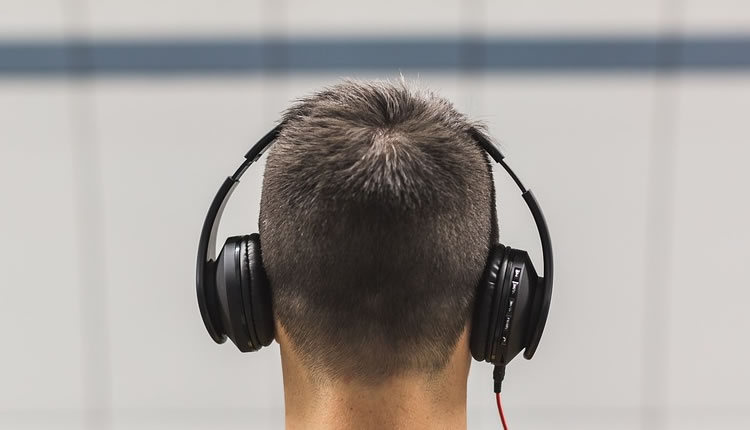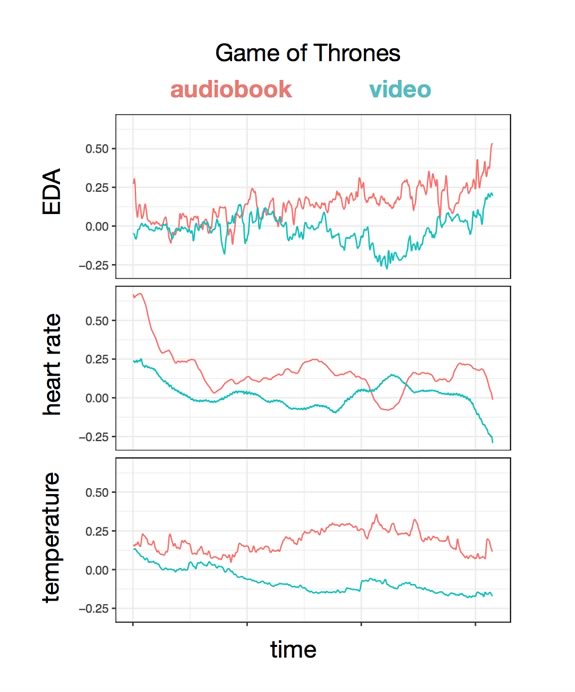Study: Winner Declared in Audio vs. Video for Emotion

Logic suggests that having vivid imagery in addition to spoken dialog should pack a bigger emotional punch, but a study at University College of London shows that audio can cause a larger jump in heart rate and other biometric measures of emotion. This might not be the end of the audio vs. video question, but it is a provocative result.
Dr. Joe Devlin and other researchers had subjects variously listen to and view dramatic scenes from Game of Thrones, Pride and Prejudice, The DaVinci Code, and other popular works. The audio versions weren’t just the audio tracks from the videos, but rather readings of the same scenes as described in the novels. No subject experienced the same content in both formats. While the subjects were listening or watching, the experimenters measured their heart rate, galvanic skin response (an indicator of emotion), and body temperature.
Video Wins in Self-reports
As you might expect, the subjects reported that the video experience was more engaging. Their questionnaire responses said that they paid more attention, were more engaged with the characters, and had a greater sense of “presence” in the story when viewing the videos.
Of course, that’s not the end of the story. Regular Neuromarketing readers know very well that self-reports aren’t always reliable.
Audio Wins in Biometrics
The audio listeners, in contrast, showed higher readings for heart rate, GSR, and body temperature compared to viewers seeing the same content in video format. Here’s the comparative data from the Game of Thrones selection in the study:

The researchers interpret the higher level of emotional arousal as an indicator that the audio content requires active imagination on the part of the listener compared to an entirely passive viewer.
But wait…
Before you switch your video resources to audio, there are a few caveats.
- The full paper suggests that motion by the subjects could have affected the biometric measurements. The video viewers tended to remain still, focused on the dramatic scene on the screen in front of them. The audio listeners had more freedom of movement, which might have affected the results.
- The narratives were dramatic fiction. The details and settings varied, but the content is distinct from most non-fiction. Your explainer video will probably work better than an explainer audio.
- As noted above, the audio wasn’t just the video sound track – it was narrative content written by skilled authors. Create the audio content from scratch.
- The lab setting almost certainly had fewer distractions for both formats than real-life settings.
- The study was sponsored by Audible. Just sayin’…
Fire Up Your Audio
If you are reading this site, you are far more likely to create business content than dramatic fantasy. Although I’ve seen some business plans that fit that description, chances are you are communicating in a more informational way. If you want to use audio effectively, learn from the best fiction writers. Use stories to engage your listeners. Make them more real with descriptive language that engages the imagination. Use sensory words – they can light the brain in the same way as the real sensory experience. I’ve never heard an audio ad for a fragrance, but the study suggests a well-written story could be effective.
Here's how to amp up your audio content for maximum emotional response. #Neuromarketing Share on XRemember, of course, that sometimes information is best conveyed in a visual way. A graph, an illustration, or a simple table can be far more effective than trying to convey the same information in spoken form.
Having said that, your audience can consume audio in many settings where watching video isn’t possible – while driving, cycling, exercising, etc. If your content can be turned into audio, test the format – you might be surprised at its impact.
